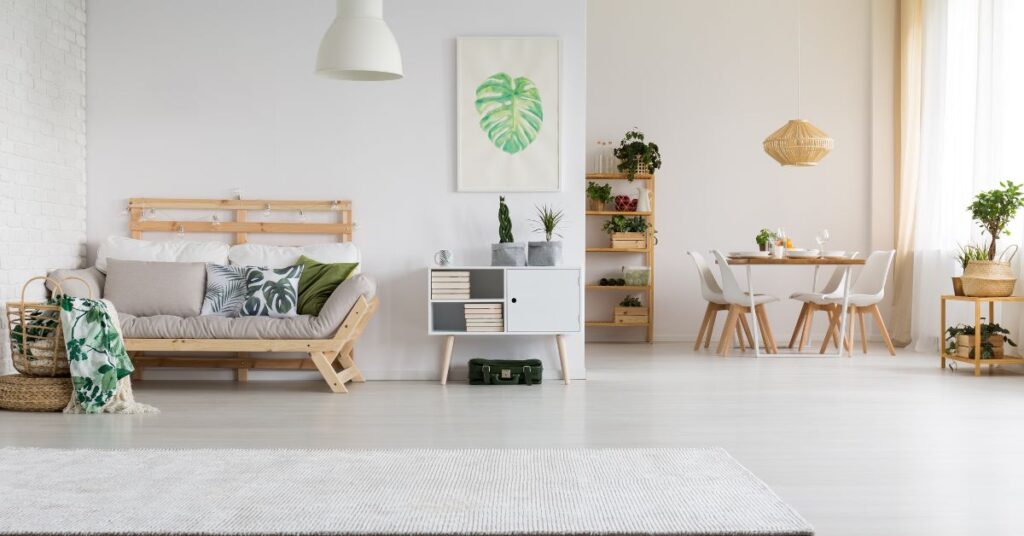Contents
- 1 Introduction to the importance of partition designs in open living spaces
- 2 Traditional vs Modern Partition Designs
- 3 Creative and Functional Partition Ideas
- 4 Materials used for partition designs
- 5 Benefits of using partitions in living and dining areas
- 6 Design considerations based on room size and layout
- 7 Tips for maintaining a cohesive design in an open space
- 8 Conclusion:
Introduction to the importance of partition designs in open living spaces

Welcome to the world of open living spaces, where blurred boundaries and seamless transitions reign supreme! In modern homes, separate living and dining areas have become a harmonious fusion. But how do you maintain that sense of distinction between these two functional zones without compromising on style or functionality? The answer lies in the artful use of partition designs.
Partition designs create a cohesive yet distinct space between your living and dining areas. They enhance the aesthetics and serve as practical solutions for privacy, noise control, and storage. Whether you lean towards traditional charm or prefer contemporary flair, a wide array of options perfectly aligns with your taste.
So let’s embark on this journey together as we explore traditional versus modern partition designs, discover creative ideas to make your space truly unique, delve into different materials used for partitions, uncover the benefits they bring to your home, consider design considerations based on room size and layout, share tips for maintaining a cohesive look in an open area…and finally find that perfect partition design that will seamlessly integrate your living and dining areas. Are you ready? Let’s get started!
Traditional vs Modern Partition Designs
When it comes to partition designs between living and dining areas, there are two main styles that you can choose from traditional and modern. Both options have unique characteristics and can add a touch of personality to your space.
Traditional partition designs often feature intricate details, such as carved wood or ornate patterns. These partitions create a sense of elegance and sophistication in the room. They can also provide privacy without completely closing off the spaces from each other.
On the other hand, modern partition designs take a more minimalist approach. These designs ‘ clean lines, sleek materials, and open concepts are standard features. Current partitions offer a contemporary look while still maintaining functionality and versatility.
One advantage of traditional partition designs is their ability to bring warmth and nostalgia into the space. They can be reminiscent of classic architectural elements in older homes or cultural influences from various regions worldwide.
In contrast, modern partition designs focus on simplicity and efficiency. They prioritize functionality by incorporating storage solutions or multi-purpose features into their design. This style is perfect for those who prefer a clean aesthetic with minimal clutter.
Choosing between traditional and modern partition designs depends on your personal preferences and the overall style of your home. Whether you go for intricate detailing or sleek minimalism, finding the right balance will ensure that your living and dining areas seamlessly blend while maintaining individuality.
Creative and Functional Partition Ideas

Looking for creative and functional partition ideas to separate your living and dining areas? Look no further! Here are some unique and original suggestions that will transform your open space into a seamless oasis.
1. Bookshelf Dividers:
Incorporate a tall bookshelf as a stylish partition between the living and dining areas. Not only does it provide storage, but it also adds visual interest and creates an inviting atmosphere.
2. Sliding Panels:
Install sliding panels made of wood or Glass to divide the spaces when needed while maintaining an open feel when left open. This versatile option allows you to control privacy without sacrificing natural light.
3. Hanging Plants:
Bring nature indoors by suspending hanging plants as dividers between the living and dining areas. Not only do they add greenery, but they also create a sense of separation while maintaining an airy ambience.
4. Folding Screens:
Opt for folding screens that can be easily moved around per your needs. These screens come in various materials such as fabric, metal, or wood, allowing you to choose one that complements your overall aesthetic.
5. Glass Partitions:
If you want to maintain an unobstructed view while still defining separate zones, consider installing glass partitions with sleek frames. This modern solution adds elegance and sophistication while creating distinct areas within the space.
6. Curtain Dividers:
For those seeking flexibility on a budget, curtains make excellent room dividers between the living and dining areas. Choose sheer fabrics for diffused light or heavier drapes for increased privacy whenever desired.
Consider factors like lighting requirements, traffic flow, and overall design cohesion when selecting from these creative partition ideas for your living and dining areas! You can seamlessly achieve functionality and style by incorporating these unique elements into your space.
Materials used for partition designs

Materials used for partition designs play a crucial role in creating a seamless and functional space between living and dining areas. Many choices, from traditional options to modern materials, are available to suit different design preferences.
One popular material for partitions is Glass. Glass can create an open and airy feel while providing some privacy. Frosted or textured Glass can add visual interest while separating the two areas.
Another option is wood, which offers warmth and natural beauty. Wooden partitions can be custom-made to match the room’s overall style, whether rustic, contemporary, or traditional. Wood also provides sound insulation, making it ideal for reducing noise transfer between spaces.
Metal partitions have gained popularity recently due to their sleek and industrial look. Steel or aluminums frames with glass panels are standard for modern partition designs. These materials are durable and easy to maintain, making them suitable for high-traffic areas.
For those looking for more unique options, materials like bamboo or fabric can add texture and visual appeal to partition designs. Bamboo screens offer a natural element that complements various decorating styles, while fabric curtains provide versatility in colour and pattern selection.
When selecting materials for your partition design, consider factors such as durability, maintenance requirements, acoustics properties if needed, and how well they harmonize with the overall aesthetic of your living and dining areas.
Benefits of using partitions in living and dining areas

- Partition designs can benefit living and dining areas, transforming a single space into distinct functional zones. One of the key advantages is improved privacy and separation between the two regions. By incorporating partitions, you can create a sense of privacy without completely closing off the spaces from each other.
- Another benefit is enhanced visual appeal. Partition designs add aesthetic charm and character to an open floor plan by introducing unique architectural elements or visually appealing materials. Whether it’s a sleek glass panel, a decorative screen, or even an artful bookshelf divider, these partitions can become focal points in your living and dining areas.
- Functionality is also significantly increased with well-designed partitions. They can provide additional storage solutions by integrating shelves or cabinets for displaying decor items or storing dinnerware. Moreover, they can help define different activities within each area – such as creating a cosy reading nook in the living space while keeping the dining area free from distractions.
- Furthermore, partitions offer flexibility in terms of room layout and arrangement. You can rearrange your furniture without constraints imposed by walls; this allows for easy reconfiguration when hosting parties or accommodating different family needs.
- Partition designs contribute to better acoustics within open spaces. With their ability to absorb sound waves and reduce noise transmission between rooms, partitions help create more peaceful environments for relaxation and entertainment.
- Incorporating well-thought-out partition designs into your living and dining areas enhances functionality and elevates style while maintaining an open-concept feel throughout your home.
Design considerations based on room size and layout
When it comes to partition designs between living and dining areas, the size and layout of your room play a crucial role in determining the most suitable method. Understanding these considerations will help you create a seamless space that maximizes function and aesthetics.
Opt for lightweight partitions for smaller rooms that do not overwhelm the space. Sliding or folding partitions are great options as they can be easily opened up when needed, creating an illusion of more space. Consider using Glass or transparent materials to allow natural light to flow throughout the room, making it feel brighter and more prominent.
You can explore different partition designs more freely in larger rooms with an open-concept layout. You can experiment with bold statement pieces such as floor-to-ceiling bookshelves or decorative screens to add visual interest while maintaining an open feel.
Consider the functionality of your partitions based on how you plan to use each area. If you often entertain guests in your dining area, consider incorporating a semi-transparent division that provides some privacy without completely closing off the space. This allows for interaction between guests while defining separate zones.
Another important consideration is choosing materials that complement your overall interior design style. For instance, if your living area features sleek modern furniture, opt for minimalist partitions made from materials like metal or acrylic. On the other hand, if you prefer a rustic or natural look, wooden partitions can add warmth and character to your space.
Consider architectural features like windows or columns when designing your partitions. They should work harmoniously with these existing elements rather than competing with them.
Considering factors such as room size, layout, functionality, materials used, and architectural features, you can ensure that your partition design seamlessly integrates into your living and dining areas while enhancing their aesthetic appeal.
Tips for maintaining a cohesive design in an open space

One of the critical challenges in designing an open living and dining space is holding a coherent look. Here are some tips to help you achieve a seamless design:
1. Define zones:
Use furniture placement, rugs, or lighting to define separate areas within the open space clearly. This will create visual boundaries without the need for physical partitions.
2. Consistent colour scheme:
Choose a harmonious colour palette between the living and dining areas. Opt for complementary colours or shades from the same family to create unity and balance.
3. Coordinate materials:
Select materials that complement each other in both spaces. For example, if you have wooden furniture in your dining area, consider incorporating wood accents or finishes in your living room.
4. Balance proportions:
Ensure that furniture sizes are proportional to each other and fit well within their respective areas. Avoid overcrowding one site while leaving another feeling empty.
5. Maintain sightlines:
Avoid tall or bulky dividers obstructing views between the spaces. Instead, opt for transparent or visually light partition designs like glass panels or open shelving units.
6. Pay attention to lighting:
Ensure consistent lighting levels using similar fixtures or bulbs across both areas.
By implementing these tips, you can maintain a cohesive design in your open living and dining space, creating a unified aesthetic that seamlessly connects these two critical areas of your home.
Conclusion:
Finding the perfect partition design for your living and dining areas is an exciting endeavour that can enhance the functionality and aesthetics of your home. You can create a seamless space that meets all your needs by carefully considering the size, layout, materials, and style options.
Remember to balance openness and privacy when choosing a partition design. Whether you opt for traditional or modern styles, make sure they complement your home’s overall look and feel. Creative ideas like folding screens or sliding panels offer versatility while adding visual interest.
When selecting materials for your partitions, consider factors such as durability, maintenance requirements, acoustic properties if needed, and how well they integrate with other elements in the room. From Glass to wood to metal or even fabric-covered dividers, countless options can suit different tastes and budgets.
Remember that partitions serve practical purposes and provide opportunities for aesthetic expression. Play with colours, patterns, and textures, or even incorporate artwork on the surfaces of your cells. This will help tie together different areas within an open floor plan while adding personality to each space.
Creating a cohesive design in an open living area requires careful planning and attention to detail. Consider factors such as furniture placement and lighting when deciding on partition designs – this will ensure harmony across both spaces without compromising functionality or style.





